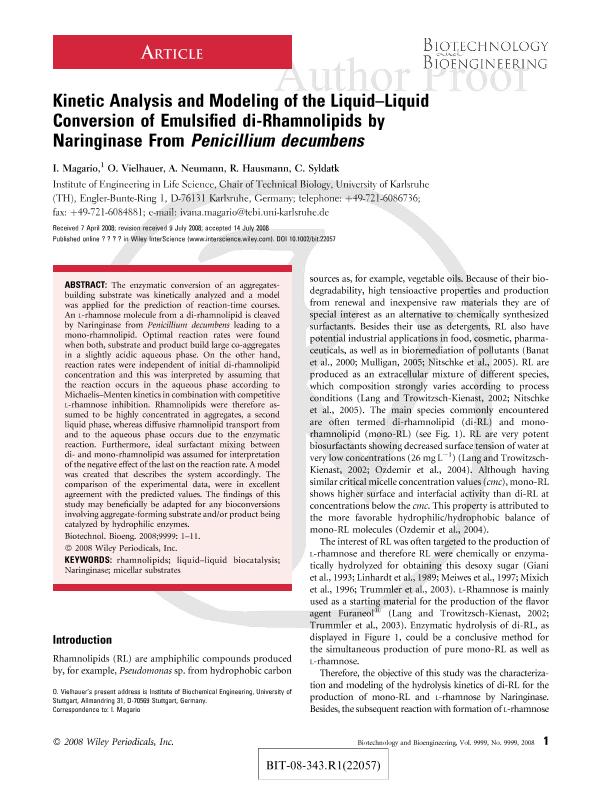Artículo
Kinetic Analysis and Modeling of the Liquid–Liquid Conversion of emulsified di-rhamnolipids by Naringinase from Penicillium decumbens
Fecha de publicación:
01/2009
Editorial:
John Wiley & Sons Inc
Revista:
Bioengineering And Biotechnology
ISSN:
0006-3592
Idioma:
Inglés
Tipo de recurso:
Artículo publicado
Clasificación temática:
Resumen
The enzymatic conversion of an aggregates building substrate was kinetically analyzed and a model was applied for the prediction of reaction-time courses. An L-rhamnose molecule from a di-rhamnolipid is cleaved by Naringinase from Penicillium decumbens leading to a mono-rhamnolipid. Optimal reaction rates were found when both, substrate and product build large co-aggregates in a slightly acidic aqueous phase. On the other hand, reaction rates were independent of initial di-rhamnolipid concentration and this was interpreted by assuming that the reaction occurs in the aqueous phase according to Michaelis–Menten kinetics in combination with competitive L-rhamnose inhibition. Rhamnolipids were therefore assumed to be highly concentrated in aggregates, a second liquid phase, whereas diffusive rhamnolipid transport from and to the aqueous phase occurs due to the enzymatic reaction. Furthermore, ideal surfactant mixing between di- and mono-rhamnolipid was assumed for interpretation of the negative effect of the last on the reaction rate. A model was created that describes the system accordingly. The comparison of the experimental data, were in excellent agreement with the predicted values. The findings of this study may beneficially be adapted for any bioconversions involving aggregate-forming substrate and/or product being catalyzed by hydrophilic enzymes.
Palabras clave:
Rhamnolipds
,
Micellar Substrates
,
Naringinase
,
Liquid-Liquid Biocatalisis
Archivos asociados
Licencia
Identificadores
Colecciones
Articulos(IMBIV)
Articulos de INST.MULTIDISCIPL.DE BIOLOGIA VEGETAL (P)
Articulos de INST.MULTIDISCIPL.DE BIOLOGIA VEGETAL (P)
Citación
Magario, Ivana; Vielhauer, Oliver; Neumann, Anke; Hausmann, Rudolf; Syldatk, Christoph; Kinetic Analysis and Modeling of the Liquid–Liquid Conversion of emulsified di-rhamnolipids by Naringinase from Penicillium decumbens; John Wiley & Sons Inc; Bioengineering And Biotechnology; 102; 1; 1-2009; 9-19
Compartir
Altmétricas




